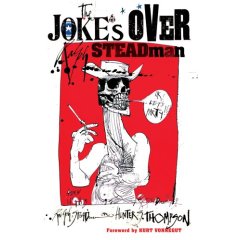 As previously noted, a few nights ago I went to mingle with Gonzo artist Ralph Steadman at the Denver Press Club, and then attended his presentation at the Denver newspapers' auditorium a few blocks away.
As previously noted, a few nights ago I went to mingle with Gonzo artist Ralph Steadman at the Denver Press Club, and then attended his presentation at the Denver newspapers' auditorium a few blocks away.Edit: See a slideshow of the evening here. I'm the one in the sunglasses, sling & black leather jacket in the photo :20 from end, as well as in the last shot, which caught me blowing on the ink splatters gracing Steadman's autograph in my copy of the book. (My hair looks godawful, but at least my outfit coordinates perfectly with the book's cover.)
Steadman was proof positive that you don't have to read from your book, or even mention it much--or even speak coherently all the time--as long as you put on a good show. Which he most certainly did.
He came onstage in the persona of his long-time partner in crime, the late Hunter S. Thompson, sporting the latter's iconic white hat and cigarette holder (see above), and muttering unintelligible imprecations.
The audience--unsurprisingly mostly male, surprisingly mostly youngish--roared its approval, whereupon Steadman tossed aside his props and proceeded to give an illustrated (natch!) talk about his 35-year working relationship with Thompson. I imagine that Steadman (who to my surprise is age 70) is a quirky speaker at the best of times, but his remarks were made especially non-linear by his professed inability to make the laptop-powered images play in chronological order. So he hopscotched dizzyingly back and forth in time and space: from drawings made during his first New York visit in 1970, to photos of Thompson in his Woody Creek, Colo., kitchen in the 1990s(?), to 1971 "Fear and Loathing" images, to photos of the bizarre contraption that launched Thompson's remains, etc.--all accompanied with anecdotes and random impressions. After awhile, one just had to sit back, relax and enjoy the flights of memory and fancy.
Steadman described how he'd often make the drawings first, then Thompson would put them up on his walls so they literally surrounded him, and only then write the story. This began with "Fear and Loathing in Las Vegas," which explains why the words and illustrations fit so seamlessly. (I still remember how the images electrified me and my friends in high school when we first saw the story--published in two parts--in Rolling Stone.) In fact, the last such series that Steadman made still adorns the walls of Thompson's home office, waiting for the words that will never come. Steadman said the pictures will remain there indefinitely. "But," he said quite firmly, "they're still mine." I wondered at his making such a point of ownership; he also stressed that he never sells his original works. Now I know why.
In the chapter entitled "Fear and Loathing: Summer 1971," Steadman quotes the rights page of the book Fear and Loathing in Las Vegas, which states the copyright holder of his illustrations as Rolling Stone founder Jann Wenner's Straight Arrow Publishers.
So, not a breath of copyright for me, Ralph Steadman. I didn't notice at the time, never read that page in the book, naturally, because the buzz was so great. Praise was overwhelming and chicanery was the last thing on my mind. The book was noticed mainly for the drawings and through the years, unknown to me, they were milked and used mercilessly....I was being gently screwed and separated, ever so silently, from my own baby. It never occurred to me that my work would be subject to so much greedy frenzy.And what remuneration did Steadman get for his baby the milch cow? (Warning: Swallow before you read further.)
...Rolling Stone paid me fifteen hundred dollars for the use of all the drawings--about twenty-four of them--and then offered to buy the originals from me, which my agent urged 'was a good move!' He sold the whole damn treasure-trove to Jann Wenner for the princely sum of sixty dollars per drawing. I rue the day I let him convince me.No wonder the subtitle of Steadman's memoir begins with "Bruised Memories"!
About an hour into Steadman's rambling, illustrated monologue, a youthful local journalist who covered Thompson for the last five years of his life interrupted and got onstage to ask questions of his own, as well as some that were written on cards by the audience. In response to a query, Steadman said that he considers his main influences to be George Grosz, Otto Dix and Francisco de Goya--not at all surprising, when you look at their work. He also answered movingly about the importance of his friendship with the famously difficult Thompson.
Steadman confounded the apparent desire of event organizers to conclude his presentation after the reporter had relinquished his spot. The slide-show commentary continued some while longer, during which at most a handful of audience members left.
Then when he had gone through every single one of his pictures--and only then--did Steadman open the floor to a few questions from his fans. Rather to my surprise, one fellow asked, "Ralph, would you sing us a song?" Apparently the guy was familiar with Steadman's shtick, because he launched into a music hall song-and-dance number that ended the night with rousing razzamatazz. For once, a standing ovation didn't seem overly generous.





1 comment:
Very cool. And you totally look the part in your leather & shades. I've always been a HUGE Steadman/Thomspson fan, and have my threadbare "Fear and Loathing" t-shirt from the 70's carefully folded away, never to be worn again lest it completely disintegrate. BATS! AARRRGH!
Post a Comment